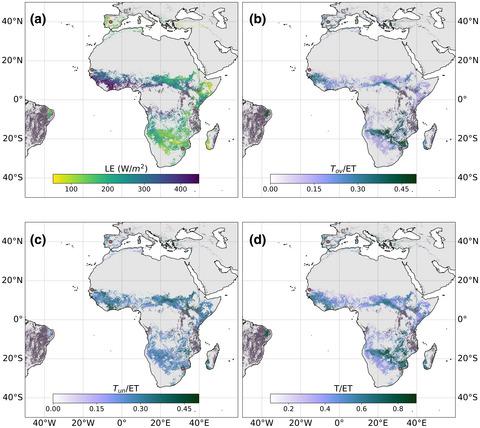当前位置:
X-MOL 学术
›
Glob. Change Biol.
›
论文详情
Our official English website, www.x-mol.net, welcomes your feedback! (Note: you will need to create a separate account there.)
A remote sensing-based three-source energy balance model to improve global estimations of evapotranspiration in semi-arid tree-grass ecosystems
Global Change Biology ( IF 11.6 ) Pub Date : 2021-11-19 , DOI: 10.1111/gcb.16002 Vicente Burchard-Levine 1 , Héctor Nieto 2 , David Riaño 1, 3 , Wiliam P Kustas 4 , Mirco Migliavacca 5 , Tarek S El-Madany 5 , Jacob A Nelson 5 , Ana Andreu 6 , Arnaud Carrara 7 , Jason Beringer 8 , Dennis Baldocchi 9 , M Pilar Martín 1
Global Change Biology ( IF 11.6 ) Pub Date : 2021-11-19 , DOI: 10.1111/gcb.16002 Vicente Burchard-Levine 1 , Héctor Nieto 2 , David Riaño 1, 3 , Wiliam P Kustas 4 , Mirco Migliavacca 5 , Tarek S El-Madany 5 , Jacob A Nelson 5 , Ana Andreu 6 , Arnaud Carrara 7 , Jason Beringer 8 , Dennis Baldocchi 9 , M Pilar Martín 1
Affiliation

|
It is well documented that energy balance and other remote sensing-based evapotranspiration (ET) models face greater uncertainty over water-limited tree-grass ecosystems (TGEs), representing nearly 1/6th of the global land surface. Their dual vegetation strata, the grass-dominated understory and tree-dominated overstory, make for distinct structural, physiological and phenological characteristics, which challenge models compared to more homogeneous and energy-limited ecosystems. Along with this, the contribution of grasses and trees to total transpiration (T), along with their different climatic drivers, is still largely unknown nor quantified in TGEs. This study proposes a thermal-based three-source energy balance (3SEB) model, accommodating an additional vegetation source within the well-known two-source energy balance (TSEB) model. The model was implemented at both tower and continental scales using eddy-covariance (EC) TGE sites, with variable tree canopy cover and rainfall (P) regimes and Meteosat Second Generation (MSG) images. 3SEB robustly simulated latent heat (LE) and related energy fluxes in all sites (Tower: LE RMSD ~60 W/m2; MSG: LE RMSD ~90 W/m2), improving over both TSEB and seasonally changing TSEB (TSEB-2S) models. In addition, 3SEB inherently partitions water fluxes between the tree, grass and soil sources. The modelled T correlated well with EC T estimates (r > .76), derived from a machine learning ET partitioning method. The T/ET was found positively related to both P and leaf area index, especially compared to the decomposed grass understory T/ET. However, trees and grasses had contrasting relations with respect to monthly P. These results demonstrate the importance in decomposing total ET into the different vegetation sources, as they have distinct climatic drivers, and hence, different relations to seasonal water availability. These promising results improved ET and energy flux estimations over complex TGEs, which may contribute to enhance global drought monitoring and understanding, and their responses to climate change feedbacks.
中文翻译:

基于遥感的三源能量平衡模型改进半干旱树草生态系统蒸发量的全球估计
有充分证据表明,能量平衡和其他基于遥感的蒸散 (ET) 模型在受水限制的树草生态系统 (TGE) 方面面临更大的不确定性,占全球陆地面积的近 1/6。它们的双重植被层,即以草为主的下层和以树木为主的上层,形成了独特的结构、生理和物候特征,与更均匀和能量有限的生态系统相比,这对模型提出了挑战。与此同时,草和树木对总蒸腾的贡献(T),以及它们不同的气候驱动因素,在 TGE 中仍然很大程度上未知或量化。本研究提出了一种基于热的三源能量平衡 (3SEB) 模型,在众所周知的双源能量平衡 (TSEB) 模型中容纳了一个额外的植被源。该模型使用涡度协方差 (EC) TGE 站点在塔和大陆尺度上实施,具有可变的树冠覆盖和降雨 ( P ) 制度以及 Meteosat 第二代 (MSG) 图像。3SEB 稳健地模拟了所有站点的潜热 (LE) 和相关能量通量(塔:LE RMSD ~60 W/m 2;MSG:LE RMSD ~90 W/m 2),改进了 TSEB 和季节性变化的 TSEB (TSEB-2S) 模型。此外,3SEB 固有地在树木、草和土壤源之间划分水通量。建模的 T 与 EC T 估计值 ( r > .76) 具有良好的相关性,该估计值源自机器学习 ET 分区方法。发现T /ET与P 和叶面积指数呈正相关,特别是与腐烂的草下层T /ET 相比。然而,树木和草在每月P. 这些结果证明了将总 ET 分解为不同植被来源的重要性,因为它们具有不同的气候驱动因素,因此与季节性水资源的关系也不同。这些有希望的结果改进了对复杂 TGE 的 ET 和能量通量估计,这可能有助于加强全球干旱监测和理解,以及它们对气候变化反馈的响应。
更新日期:2022-01-16
中文翻译:

基于遥感的三源能量平衡模型改进半干旱树草生态系统蒸发量的全球估计
有充分证据表明,能量平衡和其他基于遥感的蒸散 (ET) 模型在受水限制的树草生态系统 (TGE) 方面面临更大的不确定性,占全球陆地面积的近 1/6。它们的双重植被层,即以草为主的下层和以树木为主的上层,形成了独特的结构、生理和物候特征,与更均匀和能量有限的生态系统相比,这对模型提出了挑战。与此同时,草和树木对总蒸腾的贡献(T),以及它们不同的气候驱动因素,在 TGE 中仍然很大程度上未知或量化。本研究提出了一种基于热的三源能量平衡 (3SEB) 模型,在众所周知的双源能量平衡 (TSEB) 模型中容纳了一个额外的植被源。该模型使用涡度协方差 (EC) TGE 站点在塔和大陆尺度上实施,具有可变的树冠覆盖和降雨 ( P ) 制度以及 Meteosat 第二代 (MSG) 图像。3SEB 稳健地模拟了所有站点的潜热 (LE) 和相关能量通量(塔:LE RMSD ~60 W/m 2;MSG:LE RMSD ~90 W/m 2),改进了 TSEB 和季节性变化的 TSEB (TSEB-2S) 模型。此外,3SEB 固有地在树木、草和土壤源之间划分水通量。建模的 T 与 EC T 估计值 ( r > .76) 具有良好的相关性,该估计值源自机器学习 ET 分区方法。发现T /ET与P 和叶面积指数呈正相关,特别是与腐烂的草下层T /ET 相比。然而,树木和草在每月P. 这些结果证明了将总 ET 分解为不同植被来源的重要性,因为它们具有不同的气候驱动因素,因此与季节性水资源的关系也不同。这些有希望的结果改进了对复杂 TGE 的 ET 和能量通量估计,这可能有助于加强全球干旱监测和理解,以及它们对气候变化反馈的响应。

























 京公网安备 11010802027423号
京公网安备 11010802027423号